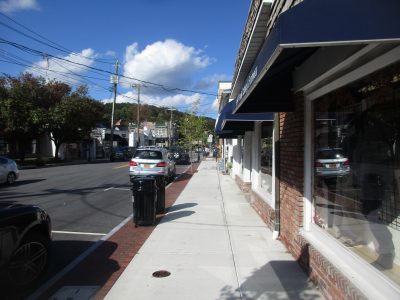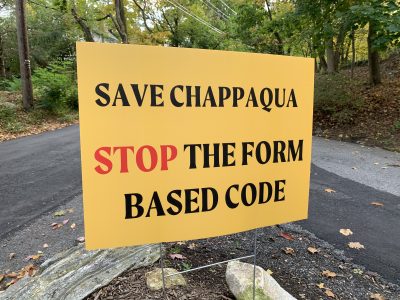New Castle Drastically Reduces Focus of Code After Public Outcry

The New Castle Town Board announced a major reduction in the focus of the Form Based Code last week, limiting the core of the downtown Chappaqua rezoning effort to North Greely Avenue.
The change came after the conclusion of the sixth public hearing session on the Draft Generic Environmental Impact Statement (DGEIS) last Tuesday where residents spoke for nearly two hours, nearly unanimously criticizing the proposed code and urging officials to restart the process so community consensus could be reached.
Supervisor Ivy Pool said North Greeley Avenue, with at least two major vacant properties, would be a good start to begin a downtown revitalization. The board recognized that the Form Based Code as proposed could generate more development than the community is willing to accept at this time, she said.
“In short, focusing on the North Greeley corridor will allow the town to take a meaningful, concrete step toward addressing some of the challenges confronting the downtown while avoiding the uncertainties that are concerning to many residents,” Pool said.
She stated that all of the town-owned property in the 72-acre study area, including the train station parking lot, as well as South Greeley Avenue would not be part of a rezoning. Pool also advocated for a community charrette to be scheduled for next year.
However, the supervisor and three of the four council members agreed that the town’s consultants should address myriad questions and concerns that were raised by residents and complete the state environmental review process. The hearing was closed but written comments will still be accepted until Mar. 25.
Councilwoman Lori Morton listed various concerns she has had with the proposed Form Based Code such as traffic and parking challenges, the potential for too much construction at one time and lack of greenspace. She supported exploring the limited North Greeley Avenue area for a rezone because the code was met by distress and outcry, which would make support difficult to obtain.
“I am encouraged by the position suggested by Supervisor Pool that allows for a test case parcel rather than implementation of the full zoning change,” Morton said. “It may allow us to test the Form Based Code hypothesis and generate some data that can be used to inform future decisions still necessary to revitalize the hamlet.”
The dissenting vote on the board was Councilwoman Lisa Katz. Katz also recited a long list of concerns, including parking, taxation and infrastructure among others. But she was also worried that the Form Based Code would be out of scale with the character of downtown Chappaqua.
Katz advocated stopping consideration of the Form Based Code and receive a wide assortment of opinions on what could work to revitalize the hamlet.
“I think that we need a genuinely diverse working group made up of town residents and stakeholders, like the Board of Education, the library, residents and every other stakeholder, and we have to form that immediately to bring an effort to conduct proper charrettes,” Katz said. “Only by doing that are we going to ensure that the residents get what they want.”

Despite the narrower focus, two frequent critics of the proposed code said they continued to have problems with the town moving forward with the state Environmental Quality Review Act (SEQRA) process. Margaret Ferguson, president of the opposition group Residents United to Save Chappaqua Hamlet, said the town has failed to achieve buy-in from residents.
“If it doesn’t achieve community consensus, (the) proposed rezoning, it’s not right for the community,” Ferguson said. “That has always been our position.”
She said even if officials limit the scope to North Greeley Avenue, should the SEQRA process be completed, there would be a four-month statute of limitations to challenge the conclusions, allowing a future board to pick up the effort for a broader rezone.
Another resident, Suzanne Chazin, said the reduction in scope doesn’t represent a change in direction.
“They’re still studying the entire area, so while they may choose to only do one section, the entire area is studied and, therefore, there is no change in direction because any time a future board, them or anyone else, can choose to do the whole thing,” she said.
Deputy Supervisor Jeremy Saland said he was disheartened by the “disinformation” generated by some in the community, with a mailer depicting massive density and building sizes. He said the most intense development outlined in the plan was never going to happen.
He supports the majority’s focus on North Greeley Avenue.
“I want to shrink the scope and the size of the Form Based Code,” Saland said. “I don’t want the Form Based Code what it is today. I have concerns over five-story buildings just like you do.”
Since October, when the public hearing opened, residents consistently blasted the initial proposal, saying it could ruin the character of the Chappaqua hamlet with buildings that could reach four or even five stories in a couple of locations and spark rampant development.
Throughout the past several months, there was considerable attention focused by critics and the Chappaqua Board of Education to the full build-out scenario, which the town was obligated to address under SEQRA. In that scenario there could be 997 new units of housing.
Hundreds of comments on the portion of the town’s website dedicated to the Form Based Code overwhelmingly panned the proposal.

Martin has more than 30 years experience covering local news in Westchester and Putnam counties, including a frequent focus on zoning and planning issues. He has been editor-in-chief of The Examiner since its inception in 2007. Read more from Martin’s editor-author bio here. Read Martin’s archived work here: https://www.theexaminernews.com/author/martin-wilbur2007/
